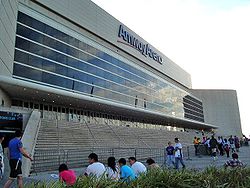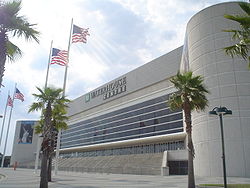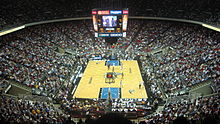- Amway Arena
-
For its successor, see Amway Center.
Amway Arena O-Rena, The Jungle 
Amway Arena in April 2010Former names Orlando Arena (1989–2000)
TD Waterhouse Centre (2000–2006)
The arena in Orlando (December 1-December 6, 2006)Location 600 West Amelia Street, downtown Orlando, Florida 32801–1107 Coordinates 28°32′56″N 81°23′12″W / 28.54889°N 81.38667°WCoordinates: 28°32′56″N 81°23′12″W / 28.54889°N 81.38667°W Broke ground 1987 Opened January 29, 1989 Closed September 30, 2010 Owner City of Orlando Operator Orlando Venues Construction cost $110 million (USD)
($195 million in 2011 dollars[1])Architect Lloyd Jones Philpot; Cambridge Seven Capacity Basketball: 15,077 (1989-1991), 15,151 (1991-1993), 15,291 (1993-1994), 16,010 (1994-1995), 17,248 (1995-2002), 17,283 (2002-2006), 17,451 (2006-2007), 17,519 (2007-2008), 17,461 (2008-2010)
Arena Football: 15,924
Ice hockey: 15,948
Circus: 15,788
Ice Skating: 16,882
Concerts:- 17,740 (end stage)
- 18,039 (center stage)
Tenants Orlando Magic (NBA) (1989–2010)
Orlando Titans (NLL) (2010)
Orlando Predators (AFL) (1991–2008, 2010)
Orlando Sharks (MISL) (2007–2008)
Orlando Miracle (WNBA) (1999–2002)
Orlando Solar Bears (IHL) (1995–2001)
Orlando Seals (ACHL/WHA2) (2002–2004)Amway Arena (formerly known as the Orlando Arena, TD Waterhouse Centre, and The arena in Orlando,[2] and colloquially known by the nickname of O-Rena) is a defunct indoor arena in Orlando, Florida. It is part of the Orlando Centroplex, a sports and entertainment complex located in Downtown Orlando. The last day of operation of the facility was on September 30, 2010 as arena operations moved to the new Amway Center. The City of Orlando has agreed to demolish Amway Arena by December 15, 2011.[3]
The arena is the former home of the Orlando Magic of the NBA and the Orlando Predators of the Arena Football League. It also hosted many other minor league sports teams, as well as various concerts and other events such as the PlayStation Pro event on the Dew Action Sports Tour and the Ringling Brothers and Barnum and Bailey Circus annually.
Contents
History
 Orlando Arena's original logo
Orlando Arena's original logo
The city of Orlando was interested in a downtown arena long before there was talk of an NBA franchise. The arena site on West Livingston Street was approved in December 1983, at a time when concerts and other large-scale events were held at the Orange County Convention Center, which is several miles away from downtown.[4] Discussions on financing delayed the project for several years due to concerns of the convention center losing money if an arena was built, as an arena would be a better venue for many of the events previously held at the convention center. By the end of 1985, the city and county reached an agreement on a financing plan that would delay the opening of the arena until the end of the decade (unless the county agreed) so it would not compete with the convention center. The planned site grew 50% from its original plan and now consumed three extra blocks south of Lake Dot.[5] In 1986, support was growing to attempt to bring an NBA franchise to Orlando, and general manager Pat Williams knew that having an arena already under construction would be critical for expansion being approved by the league.[6] Knowing the importance of the arena, the city voted to allow construction to begin before a study of its impact on the area was filed with state and regional planners.[7] Ground broke in January 1987, four months before the NBA Board of Governors made their final decision to bring Orlando into the league.
Construction was completed in 1989 at a cost of $110 million - entirely publicly financed. The arena officially opened on January 29, 1989 with a ribbon cutting ceremony and public open house featuring the Orlando Magic Dancers and Curly Neal.[8] In 1991, the facility was voted "Arena of the Year" by Performance Magazine. It was also nominated for "Best Indoor Concert Venue" in the Pollstar Concert Industry Awards. The arena's design provided for an intimate atmosphere. Spectators in the upper bowl were still relatively close to the floor due to the number of seats in the lower and upper bowls being split almost 50/50, with the luxury suites near the ceiling.[9] The arena originally seated 15,291 but all the original seats were replaced with narrower ones between 1994 and 1995, increasing capacity by over 2,000 to 17,519.[10]
Naming
After considering several names, including Frederick Arena (suggested by Magic general manager Pat Williams), MagicDome, Quest, Apex and Centrum, then-Orlando Mayor Bill Frederick decided to name the building Orlando Arena in 1988.[11] It was the city's first choice.
The city agreed to allow the Magic to sell the naming rights of the arena in November 1998. It was part of a five year extension of the team's lease on the building. The search for a corporate sponsor began immediately, and speculation began that Amway would be chosen due to the fact that Magic owner DeVos co-founded it.[12] However, in 1999, TD Waterhouse, a division of Canadian finance company Toronto Dominion, purchased the naming rights at a cost of $7.8 million for five years. The building was then renamed to TD Waterhouse Centre (utilizing Canadian spelling). Before the Orlando Arena's naming rights were sold, the other two buildings in the Orlando Centroplex—Orlando Expo Centre and Bob Carr Performing Arts Centre--utilized that spelling as well, so it was more than simply the fact that TD Waterhouse is a Canadian company that the building used the "Centre" spelling.
The naming rights with TD Waterhouse expired on November 30, 2006, and TD Ameritrade, which bought TD Waterhouse's U.S. operations earlier in the year, chose not to renew them. The venue was briefly known as "The arena in Orlando" before a new naming rights contract was signed, a period of approximately one week. On December 7, 2006, it was announced that Amway would become the new sponsor at a cost of $1.5 million over 4 years, or $375,000 a year, renaming the building as Amway Arena. As part of the deal, Amway received an initial exclusive option to negotiate for the right to name Orlando's new arena, which had just been announced. The new arena would go on to be named Amway Center.
Former Tenants
Defunct tenants of the arena include the IHL's Orlando Solar Bears, the SPHL's Orlando Seals, RHI's Orlando Jackals, MISL's Orlando Sharks, the WNBA's Orlando Miracle, and the NLL's Orlando Titans. The Solar Bears folded in 2001 along with the IHL itself. After the 2002 WNBA season, all franchises were sold to the operators of the teams, and Magic owner Rich DeVos was not interested in keeping them. They relocated to Connecticut and were renamed the Sun. On August 22, 2004, the City of Orlando evicted the Seals and they were forced to sit out the first season of Southern Professional Hockey League play for 2004–2005 as a result. They ultimately moved to Kissimmee's Silver Spurs Arena and resumed play in 2005–2006 as the Florida Seals until they folded. In 2007, the Orlando Sharks, an expansion team in the Major Indoor Soccer League, were to play in the arena beginning that fall, but rent issues with the arena led them to eventually fold. The Orlando Titans played their first and only season at the arena before folding due to financial troubles.
Renovation plans
Experts stated that the arena was outdated since the day its doors first opened.[13] Although it was built to NBA specifications at the time, construction began right before mid level luxury seating and lower level club seating became the de facto standard (the arena lacks both of these features). The Orlando Magic's desire for a major renovation of the building dates all the way back to 1994 when it was only five years old, as the team was seeking to increase revenue by expanding the limited retail & concession space and luxury seating.[14][15] In 1996, the team spent $100,000 to have Conventions Sports & Leisure of Minneapolis study and determine renovation ideas. Major renovation was beginning to seem unfeasible in 1997 when the task-force determined that the cost of implementing everything that the team wanted would reach up to $75 million.[16] The revenues brought in by the changes likely would not be enough to cover mortgage payments on money that would have to be borrowed to pay for the renovation. Also, at the time, the city still owed $40 million on the original construction of the building.
Beginning around 2000, the Magic began to push the City of Orlando for a brand new arena, replacing the TD Waterhouse Centre. Since the city, as well as Orange County, were not keen on picking up the tab for a second facility in a little over a decade, the Magic stated they would contribute to the cost of building it. They did not, however, say how much.[17] They also indicated they expected public dollars to be used, too. Discussions became contentious in 2001, as the team threatened to look elsewhere if Orlando would not build a new arena, or contribute a significant amount to a renovation. At the time, the team was losing $8 million annually. Magic President Bob Vander Weide stated, "If we can't break even in the long term and we can't stay competitive, maybe this isn't the best place for us."[18] The Magic outlined where an arena should be built, the potential cost, what type of tax should pay for it and what could be done with the existing building once it was abandoned by the team. In a meeting with county and city officials, team owner DeVos said he was seeking $200 million in public money, including $121.5 million from the tourist tax collected by the county, $50 million from the city of Orlando and $28.5 million from the state. Officials were staunchly opposed.[19] Any plans for renovation or replacement relied on tourist-tax revenue, and after the terrorist attacks of 9/11, the numbers of tourists in the area declined sharply. Then-Orlando Mayor Glenda Hood and Orange County Mayor Rich Crotty were close to a deal for a major renovation, but talks were broken off for several years due to the sagging tourist tax dollars.[13] At the grand opening of the Amway Center on October 1, 2010, Crotty remarked "When I look around this building, I think to myself, 'Boy, am I glad that didn't work.' Sometimes good comes out of bad." [20]
Successor arena
Main article: Amway CenterOn September 29, 2006, the City of Orlando and Orange County finally came to an agreement on a $1.1-billion improvement package that included $480 million for a new arena. The Magic would provide $114 million in cash and up-front lease payments and guarantee $100 million in bonds toward the arena. The venue plan received final approval on July 26, 2007, and the arena was completed in time for the 2010–11 NBA season.
Currently, plans call for the entire Centroplex, including Amway Arena, to be demolished to make way for a "Creative Village" complex on the site. It will be home to digital media companies and related industries. There will be 35% office space, 45% residential space, and 20% for other uses including education, hotels, retail, and entertainment.[21] The goal of the complex is to redevelop the site into "a place where high-tech companies locate; and employees of those businesses and other residents live, work, learn and play."[22]
Notable events
Sports
Notable basketball events include the 1990 SEC men's basketball tournament, as well as early rounds of the NCAA Tournament in the early- to mid-1990s. The 42nd annual NBA All-Star Game was held at the facility on February 9, 1992. Games 1 and 2 of the 1995 NBA Finals between the Magic and the Houston Rockets were held at the facility, as well as Games 3, 4, and 5 of the 2009 NBA Finals between the Magic and the Los Angeles Lakers. The final NBA game at Amway Arena was Game 5 of the Eastern Conference Finals against the Boston Celtics on May 26, 2010.
Other sporting events include the 1992 United States Figure Skating Championships and the IHL Finals in 1996, 1999 and 2001, when the Orlando Solar Bears won the Turner Cup in the IHL's last season of operations. During the 1993–94 NHL season, the Tampa Bay Lightning played five of their home games at the arena. In 2004, Orlando was selected as one of five cities to host the Dew Tour, an extreme sports franchise started in 2005. It was the site of the PlayStation Pro, the final event each season on the tour. Three ArenaBowl games were held at the facility. The Orlando Predators lost to the Detroit Drive in 1992 and Arizona Rattlers in 1994 before defeating the Nashville Kats in 2000. The final sporting event at Amway Arena was an Orlando Predators game on July 24, 2010 against the Oklahoma City Yard Dawgz.
Other Events
Many professional wrestling pay-per-view events have been held at Amway Arena over the years, including the 1990 WWF Royal Rumble, 1994 WCW Bash at the Beach, and WWE Armageddon 2003. On March 29, 2008, World Wrestling Entertainment held their Hall of Fame induction at the arena in conjunction with WrestleMania XXIV, which was held at the Citrus Bowl.
Many Orange County public high schools held their graduation ceremonies at the arena. In 2004, Presidential candidate John Kerry held a rally inside the arena filling the floor and most of the lower bowl. On September 20, 2008, Democratic Presidential Candidate Barack Obama held a major outdoor rally immediately outside the Amway Arena north entrance that drew over 50,000 supporters. Additional speakers at the rally included U.S. Senators Hillary Clinton and Bill Nelson. The major rally drew national attention to Florida as an election battle-ground state and was covered live on national evening newscasts on all major networks.
The final event at Amway Arena was the So You Think You Can Dance Tour on September 30, 2010.
References
- ^ Consumer Price Index (estimate) 1800–2008. Federal Reserve Bank of Minneapolis. Retrieved December 7, 2010.
- ^ "The arena in Orlando To Become Amway Arena". Retrieved 2010-03-16.
- ^ "Taxpayers Paying Thousands On Amway Arena"
- ^ "Board Backs Financing For Orlando Arena"
- ^ "Orlando Gets Moving On Arena Project"
- ^ "Magic's Williams: Orlando Arena 'Best In Country'"
- ^ "Gung-ho City Council Okays Early Construction Of Arena"
- ^ "Arena Open House". Retrieved 2010-03-16.
- ^ "Arena Model 'A Spectator's Delight'". Orlando Sentinel. 1986-09-12. http://articles.orlandosentinel.com/1986-09-12/news/0250300038_1_fillpot-orlando-magic-curved-walls. Retrieved 2010-12-18.
- ^ "Orlando Sentinel Archives"
- ^ "House of Magic: Orlando Arena". Retrieved 2010-08-17.
- ^ "O-rena May Get Profitable New Name". Retrieved 2010-08-17.
- ^ a b "Odds Improve For Td Waterhouse Upgrade". Retrieved 2010-03-16.
- ^ "Pro Sports Provide Boost" Retrieved 2010-03-16
- ^ "Orlando Arena Faces Challenge Of Keeping Fans Under Its Spell". Retrieved 2010-03-16.
- ^ "Magic's Goal: New O-rena" Retrieved 2010-03-16
- ^ "Magic May Just Redo Arena". Retrieved 2010-03-16.
- ^ "Only New Arena Will Please Magic". Retrieved 2010-03-16.
- ^ "Magic: Public Must Dig Deep For Arena". Retrieved 2010-03-16.
- ^ "Dyer, Crotty, crowd of 3,000 open Magic's Amway Center". Orlando Sentinel. 2010-10-01. http://articles.orlandosentinel.com/2010-10-01/sports/os-new-arena-kickoff-20101001_1_magic-s-amway-center-magic-president-alex-martins-hotel-taxes. Retrieved 2010-12-18.
- ^ "Downtown Orland Creative Village: Concept Team Report". http://www.cityoforlando.net/elected/venues/pdf/CreativeVillage061208_booklet.pdf.
- ^ "City of Orlando Community Venues". Cityoforlando.net. http://www.cityoforlando.net/elected/venues/creative.htm. Retrieved 2010-12-18.
External links
Events and tenants Preceded by
first arenaHome of the
Orlando Magic
1989–2010Succeeded by
Amway CenterPreceded by
first arenaHome of the
Orlando Predators
1991–2010Succeeded by
Amway CenterPreceded by
Madison Square GardenHome of the
Orlando Titans
2010Succeeded by
last arenaPreceded by
first arenaHome of the
Orlando Miracle
1999–2002Succeeded by
Mohegan Sun Arena (as Connecticut Sun)Preceded by
Charlotte ColiseumHost of the
NBA All-Star Game
1992Succeeded by
Delta CenterArenas TD Waterhouse Centre • Mohegan Sun ArenaHead coaches Administration All-Stars Tina Charles • Katie Douglas • Margo Dydek • Shannon Johnson • Asjha Jones • Taj McWilliams • Renee Montgomery • Nykesha Sales • Lindsay WhalenSeasons Playoff appearances Conference titles WNBA titles NoneRivals Media TV: CSN New England (CSN-NE) • Announcers: Mike Gorman, Meghan Culmo, Brian Scalabrine, Rebecca LoboOrlando Magic Founded in 1989 • Based in Orlando, FloridaThe Franchise Arenas Amway Arena • Amway CenterCoaches General Managers D-League Affiliate Administration RDV Sports, Inc. (Rich DeVos, Owner & Chairman) • Otis Smith (General Manager) • Stan Van Gundy (Head Coach)Retired Numbers 6 (The Sixth Man)Conference Championships (2) Division Championships (5) NBA Finals Media TVSun Sports • Fox Sports FloridaRadioWDBOAnnouncersCategories:- Amway
- Defunct arena football venues
- Defunct National Basketball Association venues
- Defunct indoor arenas
- Basketball venues in Florida
- Defunct indoor ice hockey venues in the United States
- Defunct indoor soccer venues in the United States
- Ice hockey venues in Florida
- Orlando Magic arenas
- Orlando Miracle
- Sports venues in Orlando, Florida
- Event venues established in 1989
- Tampa Bay Lightning
- Music venues in Florida
- Indoor lacrosse venues in the United States
- Orlando Sharks
- Soccer venues in Florida
- Indoor soccer venues in the United States
Wikimedia Foundation. 2010.



